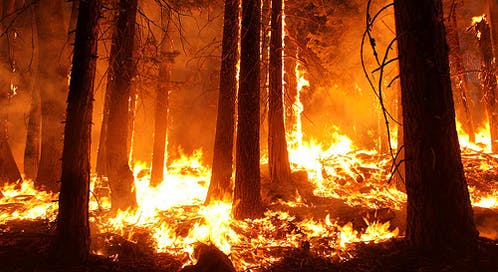Summer is nearly here-a time for fireworks, ice cream, and trips to the pool. But soaring temperatures also herald the beginning of a far more serious-and dangerous-phenomenon: wildfire season.
Many natural habitats here in the United States actually benefit from fire. Grassland fires nurture the soil and stimulate new plant growth. Small forest fires clear out dead leaves and small shrubs, returning nutrients to the soil and creating space for tree species that don’t do well in shade. These fires also help maintain larger clearings in forests and allow light to penetrate the understory, a benefit for species like the endangered Karner blue butterfly, which thrives in these pockets of open space. Several tree species need the heat from fires to release their seeds. Some habitats, like the longleaf pine forest that are home to birds like the red-cockaded woodpecker and dozens of other species, need fire in order to persist. And predators often hunt near fires, catching prey on the move.

But big, out of control wildfires are a different story, and frequently do more harm to habitat than good. These fires can burn so hot that they actually sear the soil, burning seeds and destroying nutrients. They may grow large enough to reach the forest canopy and kill large trees that normally withstand fire and provide protection and nesting habitat for wildlife. In short: small, frequent fires are usually good. Large, uncharacteristic wildfires, however, can be bad for native wildlife habitat, as can be seen in the recent California and Colorado wildfire aftermath. Why are wildfires such a problem right now? There are three major reasons:
Management. When we stop small natural fires before they run their course, tons of dead plant matter remains in the landscape. Dry leaves and branches are essentially kindling, just waiting for a lightning strike or careless campfire to go up in smoke. And in places with a legacy of clear-cutting, many forests are crowded with growth of young trees with thin bark, packed close together, allowing fires to spread.
Drought. California, parts of the Midwest and Southwestern United States are experiencing some of the worst drought conditions on record right now. In fact, as of this April, 100% of California, Utah and Nevada are in a state of moderate to exceptional drought. And where there’s drought, there are fires.
Climate change. As we know, climate change means extreme weather. Extreme heat, extreme dryness and extreme fires are all linked to global warming, and it’s only going to get worse. Research shows that the number of acres burned by wildfires has increased over the past 30 years.
The picture looks pretty bleak, and it’s true that wildfires are a serious problem that isn’t going away. But as Noah Matson says in our new climate video, Wildfires in a Warming World, there’s a lot we can do to prevent dangerous wildfires and maintain healthy fire-dependent ecosystems. Check it out!



